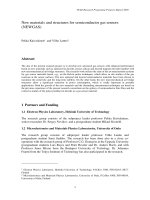ACADEMIC STUDIES ENGLISH Support Materials and Exercises for SPEAKING & LISTENING pot
Bạn đang xem bản rút gọn của tài liệu. Xem và tải ngay bản đầy đủ của tài liệu tại đây (485.47 KB, 72 trang )
ACADEMIC STUDIES
ENGLISH
Support Materials and Exercises
for
SPEAKING & LISTENING
SPRING 1999
SPEAKING & LISTENING
ACADEMIC ENGLISH
ACKNOWLEDGEMENTS
The following persons have contributed to the development of this learning material:
Content and Structure:
Curriculum Developer(s)
Leslie Childs English Curriculum Content Expert
New Brunswick Community College Bathurst
Project Supervision/Co-ordination:
Angela Acott-Smith Project Co-ordinator
New Brunswick Community College Woodstock
Kay Curtis Literacy Co-ordinator
New Brunswick Community College Woodstock
This document is available full-text on the World Wide Web thanks to
the National Adult Literacy Database.
/>The financial support for this learning materials project was provided by
the National Literacy Secretariat of Human Resources Development Canada.
Spring 1999
This support module may be used with BAU-ENG 5.1, Listening Skills; BAU-ENG
5.2, Following Oral Instructions; BAU-ENG 5.3, Speaking Skills; IAU-ENG 4.1,
Speaking Skills, and IAU-ENG 4.2, Listening Skills.
BAU-ENG 5.1 LISTENING SKILLS
OBJECTIVE
Upon successful completion of this unit, the learner will be able to
1. Take good notes from classroom discussions.
2. Take brief notes from an oral presentation.
3. Demonstrate active listening behaviour.
TEACHING POINTS Level
Active 1 importance of active listening 5/6
Listening
2 be interested 5/6
3 think about topic beforehand if possible 5/6
4 think about kind of information that might be given 5/6
5 demonstrate attending behaviours 5/6
6 avoid distracting behaviours 5/6
7 block out distractions 5/6
8 take brief notes: single words or point form 5/6
9 summarize afterwards if necessary 5/6
Developing listening skills is an ongoing process. Although this material is presented at
level 5/6, all learners, no matter what their level, can benefit from participating in
listening activities. Listening skills can be improved when learners understand that
reading comprehension skills can be applied to listening tasks (context, inference, etc.,).
Listening to (and watching) news broadcasts, informational programming, and even
situation comedies will develop listening skills, notetaking skills, and general knowledge.
BAU-ENG 5.2 FOLLOWING ORAL INSTRUCTIONS
OBJECTIVE
Upon successful completion of this unit, the learner will be able to
1. Follow oral instructions and produce results.
TEACHING POINTS Level
Following 1 use listening skills when following instructions 3/4
Oral
Instructions
2 take notes if possible 3/4
3 ask questions to clarify information 3/4
4 ask for specific details: e.g., street names, directions 3/4
5 repeat instructions to confirm interpretation 3/4
6 follow instructions sequentially 3/4
BAU-ENG 5.3 SPEAKING SKILLS
OBJECTIVE
Upon successful completion of this unit, the learner will be able to
1. express ideas and information orally.
TEACHING POINTS Level
Speaking 1 importance of complete sentences 3-6
Skills
2 correct posture 3-6
3 eye contact 3-6
4 good pronunciation 3-6
5 appropriate auditory levels 3-6
6 discuss body language, gestures, etc. 3-6
7 personal space 3-6
Because public speaking is perceived as such a “dangerous” venture for most upgrading
students, it should be handled as quietly and non-stressfully as possible. Every learner
needs to work towards a “stand up” oral presentation. Learners at the BAU level can
begin to develop confidence in speaking in public by contributing in class discussions,
interpersonal exchanges, asking and answering questions orally, making and receiving
phone calls, asking directions, role playing, etc. Learners should be given every
opportunity to build their confidence levels and to speak aloud without placing them in a
situation where they feel threatened. Learners at BAU level do not need to make a
formal speech unless they feel ready.
IAU-ENG 5.1 SPEAKING SKILLS
OBJECTIVE
Upon successful completion of this unit, the learner will be able to
1.create and deliver a variety of short informal presentations
TEACHING POINTS Level
Skills 1 Use the writing process 7
2 Strong purpose stated early, good audience assessment 7
3 Voice control (tone, pitch, rate) 7
4 Eye contact (constant and varied) 7
5 Avoid mannerisms 7
6 Effective gestures and posture 7
7 Frequent repetition 7
8 Clearer order 7
9 Stronger and more frequent transitions than essays 7
10 Frequent summaries than essays 7
11 Vary speed to keep audience attention 7
12 Numbered lists 7
Graphics 13 Overheads, posters, props 7
14 Charts, graphs, videos 7
Types 15 Memorized 7
of
Delivery
16 Read 7
17 Extemporaneous 7
18 Strengths and weaknesses of the above 7
Learners at all levels should regularly make oral presentations. See note in curriculum
plan for suggested activities at each level.
IAU-ENG 4.2 LISTENING SKILLS
OBJECTIVE
Upon successful completion of this unit, the learner will be able to
1. listen effectively and attentively to an oral presentation of moderate length
(20-30 minutes).
2. listen to and interpret instructions.
3. take notes and ask appropriate questions.
TEACHING POINTS Level
Types 1 Marginal 7
2 Attentive 7
3 Critical 7
4 Appreciative 7
Strategies 5 Ask questions 7
6 Identify parts of an assignment 7
7 Isolate: purpose 7
8 main idea 7
9 transitions and signals 7
10 summaries 7
11 conclusions 7
12 Take notes (develop personal short hand) 7
13 Prepare to listen: listen with a purpose 7
14 think about topic beforehand 7
15 do some research ahead of time 7
16 Formulate questions that you think speaker can answer 7
17 Visualize what you hear 7
18 Review what you hear as you go along 7
19 Arrive early, be comfortable, don’t eat big lunch 7
20 Differentiate between fact and opinion 7
21 Use tape recorder if you have permission 7
Listening in a variety of situations should be practised regularly at all levels.
TABLE OF CONTENTS
INTRODUCTION 1
THE IMPORTANCE OF SPEAKING AND LISTENING 2
SPEAKING SKILLS 3
PREPARING A FORMAL ORAL PRESENTATION 11
What Your Audience Sees 20
What Your Audience Hears 22
Summary 24
LISTENING SKILLS 26
WHAT IS LISTENING? 27
TYPES OF LISTENING 31
DECIDING HOW TO LISTEN 36
STRATEGIES FOR EFFECTIVE LISTENING 37
CONCLUSION 44
ORAL PRESENTATIONS: SAMPLE EVALUATION SHEET 48
EXERCISES AND ANSWER KEY 49
BAU PRE-TEST 57
ANSWER KEY FOR BAU PRE-TEST 58
IAU PRE-TEST 59
ANSWER KEY FOR IAU PRE-TEST 60
ORAL PRESENTATIONS: EVALUATION SHEET 62
FEEDBACK FORM 32
1
For more detailed information on the communication process, see the module Writing
1
Paragraphs in this series.
SPEAKING AND LISTENING
INTRODUCTION•
Every English course you will ever take is really about how to communicate
effectively. Communication is a multi-step process that requires at least two people
1
who have something to “say” to each other. In order to be successful, each
communication requires (1) someone to send the message; (2) the message itself; and
(3) someone to receive it. When people want to exchange ideas, they have only
three ways to do it.
THE COMMUNICATION PROCESS requires
A SENDER who A MESSAGE which A RECEIVER who
writes the message uses words reads the message
uses body language to uses actions: gestures, views the non-verbal message
send a message facial expressions,
body language
speaks the message uses words and actions listens to the message
All communication is incomplete until someone has received and correctly
understood the sender’s ideas. Would you accomplish anything if you wrote a
complaint letter and never mailed it, or talked into a disconnected telephone?
English courses focus most on building writing and reading skills. The two
other ways of communicating are also important, yet they are seldom taught. This
module focuses on the information you need to make oral communications (speaking
and listening) useful tools in your everyday life, at home, at work, and in the
community.
2
L. Barker, R. Edwards, C. Gaines, K. Gladney, and F. Holley, “An Investigation of
2
Proportional Time Spent in Various Communication Activities by College Students” Journal of
Applied Communication Research 8 (1981): 101-109.
Research summarized in A.D. Wolvin and C.G. Coakley, “A Survey of the Status of
3
Listening Training in Some Fortune 500 Corporations,” Communication Education 40 (1991):
152-164.
THE IMPORTANCE OF SPEAKING AND LISTENING•
Speaking and listening make up 69% of our total communicating time each
day. One study showed that college students spent about 53% of their time listening
and 16% speaking, but only 14% writing and 17% reading . It’s not just college
2
students who spend large portions of their time listening either. Another study
showed that most employees in North America spend about 60% of their day
listening to each other.
3
Since most of our time is spent speaking and listening, it is not surprising that
these two areas are often the source of misunderstandings between people. Marriage
counsellors report that many clients say that their partner doesn’t listen to them;
however, some misunderstandings may come from the fact that speakers often don’t
say what they mean clearly enough.
3
An untrue story or idea that most people believe.
4
Ronald B. Adler, George Rodman, “Understanding Human Communication”. Toronto:
5
Harcourt Brace College Publishers, 1997.
It is a myth that speaking and listening are natural activities (like breathing)
4
that we all do well without any training. It is true, however, that most people can
become better at both. Surprisingly, little time is given to teaching these very
important skills despite the large part they play in everyday learning and
communication. The following table shows just how important it is to take this
5
opportunity to improve your oral communications skills.
Comparison of Communication Activities
Listening Speaking Reading Writing
Learned First Second Third Fourth
Used Most Next to most Next to Least Least
Taught Least Next to least Next to Most Most
SPEAKING SKILLS•
Human beings use their voices from the moment they are born to communicate
with the world around them. Babies cry to tell their parents they are hungry, cold, or
frightened, and they make happy noises when they are content.
No matter how vocal babies are however, they cannot tell the
care giver exactly what they want. At about 12 months of age,
toddlers begin to develop spoken language skills that make
their needs and moods clearer. Slowly they begin to speak by
imitating the language they hear around them every day. By
age five, they usually speak in clear, mostly correct
grammatical sentences. After that, they continue to build their
vocabulary and learn how to use words to (1) share
information or (2) persuade those around them. What could be more persuasive than
a sixteen-year-old asking for the car keys on the day after he/she gets a driver’s
licence? Children (and adults) talk to each other all the time: they make plans
together, exchange ideas, discuss friends, rehash sports events, and resolve disputes.
4
They do it without fear or hesitation, almost automatically and often feel lonely if
they go for any period of time without someone to talk to. Conversations, sometimes
called interpersonal communications, are an enjoyable part of everyday life.
EXERCISE 1•
Survey your own interpersonal communications by answering these questions.
1) Count the number of different conversations you have in one hour.
2) Who spoke first? You? Or the other person?
2) How long does each one last?
3) What was the purpose and topic of each exchange?
4) What emotions did you feel during each conversation?
5) How many times do you answer the phone in a day?
6) What words or phrases do you use when answering the phone?
7) How can you tell when someone isn’t listening to you? What do you do to
make them pay attention?
8) How many different people do you speak to in a day? In a week? Do you
speak to everyone the same way? What are the differences?
9) Estimate how many minutes you spent speaking yesterday?
Examine your attitudes about talking to friends and family by answering these
questions.
1) Who do you look forward to talking to most? Least? Why?
2) What topics are likely to make you angry? Bored? Laugh?
3) How do you respond to a speaker when you feel angry? Bored? Amused?
4) How much time do you spend in conversation in an average day?
5) How much of this is face to face? On the telephone? On the Internet?
6) When do you generally not want to talk to someone?
7) How do you feel about telephone salespeople? Survey takers?
8) What telephone habit of others makes you most impatient?
9) Do you plan what you are going to say before you speak? If yes, under
what circumstances?
Think about how you feel when speaking to strangers.
1) Have you ever answered the phone and spoken to someone you didn’t
know? How did you feel?
2) Do you feel embarrassed, scared, uncomfortable when you meet new
5
people? Why? Why not?
3) When was the last time you asked someone a question? How did you feel?
4) Do you ever ask directions when you are travelling?
5) Do you usually make an effort to speak to new people in your class?
Why? Why not?
6) Have you ever explained something to a classmate? What was it? How
did you feel afterwards?
If you have done any of these things, you have spoken in public. Why do so
many people feel frightened by the idea of speaking to a group? Think about it.
What makes a speech so much more difficult than talking to a three or four of your
friends or family? Some people may answer, “Everyone is watching me.” That’s
true, but people always watch each other when they speak, even when ordering a cup
of coffee or thanking someone for holding a door. It’s something we’ve all been
taught to do when we listen. It’s polite; it shows we are
listening; it helps us use the facial expressions and
gestures that are part of every spoken message. Other
people say, “I’m really afraid I’ll make a mistake.” Of
course, this is a concern. No one wants to make
mistakes, but they happen regularly to everyone and
most of the time listeners don’t even notice them. If you
are well prepared, any mistakes you make will be so
small that people won’t even notice. Still others say,
“What if I say the wrong thing? People will think I’m
stupid.” The point of giving a speech is to give the audience information it doesn’t
have. If you match your topic to the listeners’ information needs, know your subject
well and have done good research, your facts will be correct and you will likely
know more about the subject than your audience.
6
EXERCISE 2•
Analyze how you feel about speaking in public by answering these questions.
1) Have you ever spoken in public? When? How often? What was the occasion?
2) Were you scared? Did you have “stage fright”? Why do you think you felt that
way?
3) Have you ever made a “speech”? When? What was the situation? How and why
did you make yourself go through with it?
4) How well do you think you did?
5) Did anyone compliment you on your speaking?
6) Did anyone make fun of you?
7) Did anyone criticize what you said or how you said it?
8) When was the last time you listened to someone make a speech? How did you
behave as a listener?
The most common reasons people give for feeling uncomfortable with public
speaking relate to the audience. An audience is little different from the people you
chat with over coffee or visit with at home; they are all really just listeners who need
or want information. One of the best ways to make yourself feel more comfortable
with the idea of making a speech is to think about how you listen. When you listen
to a speech, do you laugh and point if the speaker forgets what he/she wants to say?
Do you think the person is stupid just because you can’t hear him/her or the
overhead projector doesn’t work? You would probably never do anything to make
the speaker feel uncomfortable, so why should you think anyone would do it to you?
In fact, audiences show patience and sympathy for a speaker when things are going
wrong. And, believe it or not, despite the speaker’s worst fears, most things usually
go right in an oral presentation.
Public speaking only seems threatening to you because it is a new experience.
You may have felt nervous the first time you asked a question in class, but once you
had done it a few times you realize that nothing terrible happened. Soon, you asked
questions without thinking about it. The same is true for public speaking. The more
experience you get, the easier it becomes. No matter how skilled at public speaking,
no one ever completely loses his/her stage fright, and most speakers agree that a little
bit of nervousness makes for a better presentation.
When you follow the guidelines in this module, you will develop a skill that
many people wish they had. You will be able to speak in public to small groups and
7
large audiences. Often the ability to speak well is the key to success at work. Many
people are so terrified of public speaking that they refuse to do it. As a result,
employers are always glad to find someone who can promote their products or
services effectively. Good public speaking skills, like writing skills, are always in
demand and having them can often make the difference between being laid off and
kept on, or being promoted or passed over.
If you are new to upgrading, no one expects you to make a speech right away.
You will always have a chance to work up to it. There are many aspects of public
speaking that you can practice every day without having to stand up at the front of
the room or speak into a microphone.
EXERCISE 3•
Make an effort to do some or all of the following activities.
1. Ask the facilitator questions about your work. Think about what you need to
know and exactly what information you need before you ask the question.
Make sure you give the listener enough information so he/she can respond to
your request. Don’t just say, “I can’t do this.” Instead say, “I’m having
trouble finding the subject (or verb, or adjective, etc.) in sentence number 4.
Could you help me?” or “Could you show me how to divide fractions again?
I can’t remember which part to invert.”
2. Participate in coffee break discussions. Listen carefully until you get the main
idea. Then add your opinion or ask a question to get more information.
People always like to explain things they know about.
3. Help plan a class activity. Many classrooms have pot luck suppers or hold
raffles to raise money. Share your ideas whenever possible.
4. Ask questions of guest speakers. Asking a question, no matter how simple,
makes the speaker feel that you were interested in the topic and liked their
presentation. It also gives them an opportunity to talk even more about
something that is important to them.
5. Contribute to classroom discussions. Don’t always be a listener. You have an
opinions, and they are just as good as anyone else’s. Share them with your
classmates. They may not always agree with you, but at least you’ve had your
say. Classroom discussions are an important part of the learning and
remembering because they allow you to review what you’ve already learned,
organize facts into new patterns, and learn more about a subject.
6. Answer a classmate’s questions. When someone wonders about a fact, look
8
up the information and then report your findings to the group. You don’t have
to stand up and make a formal speech. Just sit in your seat and share the
information you found.
7. Answer the telephone in the classroom. If you don’t already feel comfortable
doing this, think up a good greeting. Write it down and leave it near the phone
so you can read it after you pick up the phone. You might choose to say,
“Good morning, adult upgrading.” or “Adult upgrading. How may I help
you?” or “CASP classroom. This is Martha speaking.”
Think about what kind of voice you would like to hear if you were thinking
about coming back to school and finally got the courage to make that first
phone call.
8. Make phone calls relating to your own or class business. Perhaps you need to
order supplies, ask for donations for a fundraiser, or arrange a time for a guest
speaker
9. Interview people in your community about upcoming events or local history.
You’ll make them feel good about themselves, and you’ll be practicing public
speaking. At the same time, you will probably learn some interesting facts
you didn’t know before.
10. Be one of the first to speak to a new student on his/her first day. Think about
how you were greeted and what you wanted to know on your first day, and
then act accordingly.
EXERCISE 4•
Do a mini-research project and share what you found with the rest of the class. You
might be curious about a famous person born in your town, or interested in a recipe
for home-made wine, or want to know more about a person, place or thing you have
read about.
Here are some suggested topics that you can report on in a few sentences
while sitting at your desk.
1. Who was Bonar Law? Where in New Brunswick would you go to see
his boyhood home?
2. Who was “Boss” Gibson? What is his connection with the Fredericton
area?
3. What are the rules and/or laws covering salmon fishing in New
Brunswick?
4. How long is the Miramichi River? Where does it begin?
5. Where was Fort Cumberland (Beauséjour)? Why was the name
changed?
9
6. Who was Nicholas Denys? Why did he move around so much?
7. Where is Madawaska? What does its flag look like? Why?
8. What is New Brunswick’s provincial flower? Bird?
9. How many litres make a gallon? Centimetres in an inch? Kilograms in
a pound? Kilometres in a mile? What mnemonic might help you
remember?
10. How many Canadian dollars would it take to buy $100 American? How
much Canadian money would you get if you changed an American $100
bill at the bank?
11. What is the current mortgage rate? Car loan rate? Personal loan rate?
12. Where do kiwi fruit come from?
13. Name three kinds of clouds and describe what each looks like.
14. What is a platypus? Where does it come from? What does it look like?
15. What is a phoenix?
Doing any of these activities is a good way to start building your confidence
about speaking in public. When you are working in your own classroom, or
someplace where you feel comfortable, you will feel more relaxed
about oral presentations. Everyone has to start somewhere, and a
single word dropped into a conversation at coffee break is as good
a place to start as any. As you become more relaxed, progress
towards a more formal situation, by standing beside your desk as
you speak. Eventually, you will be ready to stand at the front of
the room, or even use a microphone. Think about this. What, if anything, is the real
difference between sitting at your desk while you tell a story and standing at the front
of the room doing the same thing? Do one thing that frightens you every day, and
you will be surprised at the difference it makes in your life.
EXERCISE 5•
Do any seven of the following informal speaking activities.
1. Say “thank you” warmly to a stranger who opens a door for you. Watch that
person’s face as you speak. What did you observe?
2. Call a local store and ask about the availability and cost of a product you
might need. Tell someone in your group what you found out.
3. Research one of the following topics and report (in four or five sentences) to
the class while standing at your desk.
10
A) Mackenzie River E) Loyalists in New Brunswick
B) Nunavut F) A Local Figure
C) Lester Bowles Pearson G) The Early Days in Your Town
D) K.C. Irving H) A Topic of Your Choice
4. Participate in a class discussion by clearly stating your opinion (with reasons).
5. Create a polite way to answer the telephone for your CASP classroom. If
possible, take responsibility for answering the phone for a week.
6. Plan and lead a game in your classroom or at some social function.
7. Create a survey of three or four questions. Then conduct the survey both in
your classroom and in some public place. Report your results to the class.
8. Volunteer to sell tickets or do some volunteer work that includes speaking to
people.
9. Think up a class activity, field trip, or fund raiser. Then briefly present your
ideas to the group.
10. Call in to a radio talk show or request line.
11. Ask someone in your community how to get to a specific location.
12. Call an 800 (toll free) information line with a question, comment, compliment
or complaint about a product.
As your language skills grow and you develop more confidence, you will be
moving toward making a formal oral presentation. Your instructor will help you
decide when you are ready to start work on your formal speech. You will learn more
and make much better progress if you make many short speeches rather than doing
just one long one, so begin with a series of short presentations, perhaps once a week.
At first, they can be less than a minute in length. Later, you can prepare more
material that might take two or three minutes, five minutes, and finally about ten
minutes.
11
EXERCISE 6 (BAU optional)
Here are some topics you can do in a short time while standing beside your
desk. These are informal speaking situations. Do several of them until you start to
feel comfortable speaking in casual situations.
1. Bring a special item from home and tell where you got it and why it’s
important to you.
2. If you play an instrument, do a song and tell why you like it.
3. If you don’t play an instrument, play a tape of your favourite song and then
talk about it.
4. Bring the ingredients for a simple recipe and show the class how to make it.
Then share the results at lunch or coffee break.
5. Read a short article and comment on it.
6. Find a big picture or poster and describe what it means to you and why you
like it.
7. Organize a spelling bee (or similar contest) and supervise it.
8. Demonstrate your hobby.
9. Research a famous person and report your findings (two minutes). Be sure to
tell why you think that person is important to you, or your community, or the
world.
10. Bring your pet and tell what you know or describe some of the funny, clever
things it can do.
11. Any topic of your choice.
PREPARING A FORMAL ORAL PRESENTATION
The first stages of preparation of an oral presentation are very similar to
writing a longer essay or informal report. The prewriting, researching, and planning
steps and stages are the same. If you need to review these, look at the modules
Writing Longer Essays and Writing Informal Reports. With your instructor’s
permission, you may even be able to adapt the topic of the essay or report you wrote
(or vice versa). You need to have something to say before you can move on to
deciding how you want to present your ideas.
It is important to remember, however, that a speech is quite different from a
written essay. Speeches are usually less formal than essays so the sentences are
shorter and the language a little easier. Exact words are really important in a speech
because the listener needs to form a mind picture of what you are talking about.
12
He/she he can’t reread a sentence that is fuzzy; as a result, your words have to be
very clear the first time.
Because listeners can’t reread or review the material, they need strong
introductions that state the main idea clearly and summarize the major headings that
will be covered. Your material must be organized in a consistent and logical way so
the listener can follow your train of thought. In addition, much stronger and more
frequent transitions help to remind listeners of where you are in your presentation.
Listening to a speech means that the audience has to work harder to remember
what has been said, so it is a good idea to repeat details, ideas, and opinions more
often than you would in an essay. Numbered lists, repetition, and frequent reviews of
facts and major headings make it easier for your listener to understand and remember
your message. Formal presentations also need stronger conclusions that summarize
the main points.
One last item can make the difference between an average speech and an
exceptional one. Graphics, such as pictures, visual aids, and charts are really useful
in helping the audience stay focused on the message as well as understand exactly
what you are talking about. For instance, in a speech about early ship building,
provide large pictures of the kinds of ships you are describing. Always check to
make sure that the pictures are large enough and clear enough to be seen easily from
every corner of the room. Charts and graphs should be kept simple so they can be
easily understood. If you talk about sails, bring a piece of sailcloth to use as a
“prop” which can be passed around. Use “pass-arounds” carefully because the
audience will focus their attention on what they are handling and stop listening to
you. Once you have lost their attention, it will be difficult to get it
back. To explain comparisons, use large (at least the size of a
piece of poster board) charts and graphs with lots of bright
colours. Sometimes, actual demonstrations of difficult techniques
or part of an audio or video tape will make your point clearer.
Use graphics and props in almost every speech you make.
DELIVERING AN ORAL PRESENTATION
Writing, revising, and proofreading are essential steps in preparing an essay or
13
A small elevated table used by speakers to hold their notes.
6
report, but writing out the words you want to say may not be the best way to get
ready to deliver a speech. There are four basic ways to deliver an oral presentation.
Extemporaneous
Impromptu
Manuscript
Memorized
Each type of delivery requires slightly different kinds of preparation and has a
different effect on the audience. As part of your planning process, you need to
decide which method is going to be most effective and most appropriate for the
specific audience you will be addressing. Although a speech may use a variety of
methods of delivery, it’s easier to learn about each type separately.
1. Extemporaneous Speeches
This is a long word and you may need to add it to your spelling list, but it is
not difficult to understand. An extemporaneous speech is thoroughly planned but it
is delivered in a spontaneous way and sounds much like a conversation. Your
audience will feel that you are talking honestly to each one of them individually.
Extemporaneous speeches are easy and enjoyable to listen to.
Just because extemporaneous speeches sound like they are made up as the
speaker goes along doesn’t mean that they aren’t carefully planned and practiced.
They create the illusion of being brand-new, never-before spoken words. They are
never memorized; the exact wording is never planned or written down!
So how do you prepare for an extemporaneous speech.
First, know your material well. The best topics for
extemporaneous speeches are those you are really familiar with
and have been involved with for some time. For example, if you
are into organic gardening, you probably know most of the things
you want to say because you use the information yourself every
day. All you need to do is decide on three or four areas you want to present: perhaps
soil types, fertilizers, mulch, and pest control. These general topics form the
skeleton plan of your speech. Write each one in large, easily readable letters, on a
series of cards that are small enough to fit in your hand or on a podium . Next, think
6
14
of subheadings you want to cover for each section. Under soil types, you might want
to talk about sandy soil, clay soil, and loam as well as ways to enrich each one.
Write each soil type on a separate card along with one or two words to remind you
of the facts you need to cover. When you have done this for each subheading,
arrange the cards in the most logical order and you are ready to stand in front of a
group of five friends or five hundred gardeners and talk about your theories of
organic gardening. Using your cards as a guide, you simply tell what you know.
You might also want to prepare cards that carry new facts you found in your
research, quotes you want to use in your speech, and numbers or statistics that you
want to be sure and get right. It’s alright to read these, but the rest of your speech
should sound spontaneous.
Remember to clearly indicate each change of subtopic and review important
ideas as you go along. For example the first card in each subsection might carry
phrases like this:
I # 5
The FIRST thing organic gardeners need to think about is
SOIL TYPE.
II # 14
The SECOND major concern right after soil type is
FERTILIZER.
IV #19
Even though you’ve looked after soil types, fertilizers, and
mulches, the LAST and MOST IMPORTANT concern for
organic gardeners is how to CONTROL PESTS without using
chemicals.
15
Well known
7
Extemporaneous speeches are generally the most effective way to present
information to an audience, and they are also the most common type, particularly in
the workplace. Because you have very little down on paper, you will need to
practice delivering your speech from your cards several times until each section and
idea follow one another automatically in your mind. Some speakers practice in front
of a mirror so they can get an idea of what kind of gestures and movements will
make their speech more interesting and effective.
This type of delivery does have some disadvantages. It is harder to stay
within strict time limits if you are “talking” your material. As well, it is almost
impossible to get the wording exactly right (for quotes and important details,
however, you can read from your cards), and you may make a few grammar mistakes
or leave out minor details.
If your speech is going to be taped, televised, or reproduced for use with other
groups, the extemporaneous speech may not be the most appropriate method of
delivery as your mistakes and omissions will be recorded and replayed over and
over.
2. Impromptu Speeches
You may not always have the time to prepare an extemporaneous speech.
When you don’t, you find yourself talking about a topic “off the top of your head”.
This kind of oral presentation is called an impromptu speech and can be pretty
frightening if you don’t know how to handle it. At work, you may be asked to speak
to a meeting because the scheduled speaker is sick or forgot to come. In volunteer
organizations, speakers are notorious for forgetting to show up. The chairperson of
7
the meeting sees you in the audience and realizes that you know something about the
topic so he/she won’t have to “do his stand-up comedy routine after all”. Suddenly,
you may be the one who is filling a few minutes in the program. The impromptu
speech is truly spontaneous, while the extemporaneous speech only sounds that way.
Although impromptu speeches are always challenging, they do have their
benefits. First, you usually don’t have to speak for long. Second, your audience will
16
Short narrative stories, often based on real life experiences.
8
understand that you weren’t really prepared, and likely respond positively. Third,
learning to do impromptu speeches is really useful because it teaches you to stand up
at a business or community meeting and make your opinions heard on the spur of the
moment. Your boss will love you because you filled in an embarrassing moment for
him/her. Lastly, practicing speaking in impromptu situations teaches you two
valuable skills: thinking on your feet and organize your thoughts logically. Here are
some hints for creating a good impromptu speech.
1. Take advantage of the time between being asked to speak and actually
speaking, even if it is only a minute to brainstorm for ideas, just like in the
prewriting process. You could do a quick cluster, or perhaps use the
classification method of development. In other words, think of two or three
categories under which the topic could be discussed. For example at a
provincial literacy meeting, you are asked to speak about the problems facing
adult students returning to school that administrators need to take into account.
Quickly, you scribble three topics on the back of a napkin: money, time, and
transportation. (After all, everyone has trouble with these.) Under each one
you list some specific problems. Your rough notes might look like this.
money: no income, growing children cost more, mortgage, taxes
no money for extra books like dictionaries or other school supplies
no money for proper nutrition or good job hunting clothes
need part time job just to keep food on table
time: hard to do homework, part time job sometimes interferes.
have family/home responsibilities
takes a long time to get the skills you missed the first time around
classes should be more hours a week
need access to teacher or tutor on weekends
transportation: no reliable vehicle, especially in winter
have to rely on friend for rides
2. Don’t be afraid to be original. Rely on personal experiences which you know
well and can talk about easily. Since you are only “filling in”, you can
probably be more entertaining than informative, so anecdotes may be
8
appropriate.
3. Consider simply answering the questions who, what, when, where, why, and
how in your speech.
17
4. Use something an earlier speaker said and respond to it. Whether you agree
or disagree with them may not be all that important
5. Always be positive. Don’t whine and complain about the situation. Smile
lots. Humour often gets you through tough situations.
6. You don’t have to be “too up tight”. The audience understands the situation
and will be very sympathetic.
7. Keep your comments brief. Do not be tempted to retell your life story in
detail. If you finish early, or on the schedule, the audience will be delighted
with a longer coffee break or an earlier finish to the day.
3. Manuscript Speeches
This is just a fancy of way of saying that the speaker is reading a prepared
text. This kind of delivery is best if your speech is being recorded or if you are
presenting a lot of numbers and details that the audience needs to use later. When
it’s essential that you get things absolutely correct, use a manuscript. Politicians,
lawyers, and executives often read prepared statements, especially at press
conferences because they need complete control over what they say. If something is
televised, the manuscript reader may use a Teleprompter. This is a device like a
television screen that displays the words in large type and scrolls through the whole
speech slowly enough so it can be read easily. When a Teleprompter is used, the
audience feels that the speech is spontaneous because the speaker appears to be
looking directly into the camera and into the viewers’ eyes. Often manuscripts are
written by someone other than the person reading them. As well, they often include
stage directions, like “LOOK AT THE AUDIENCE”, “PAUSE AND SMILE”, “S-
L-O-W-L-Y”
Written speeches are difficult to write because every word counts and the
person delivering it will be held accountable for every word, fact, and opinion. If
you should have to write one, here are some guidelines.
1. A written speech is not just an essay that you read out
loud. Generally, they are less formal and use shorter
sentences and simpler words. Because they should
sound as spontaneous as possible, use conversational
phrases like “as you can see”, or “if you remember”,
or “Well, when you consider this”.
2. Short paragraphs make it easier for the reader to find his/her place in the text.
3. Use large letters and dark type so it’s easy to read.









